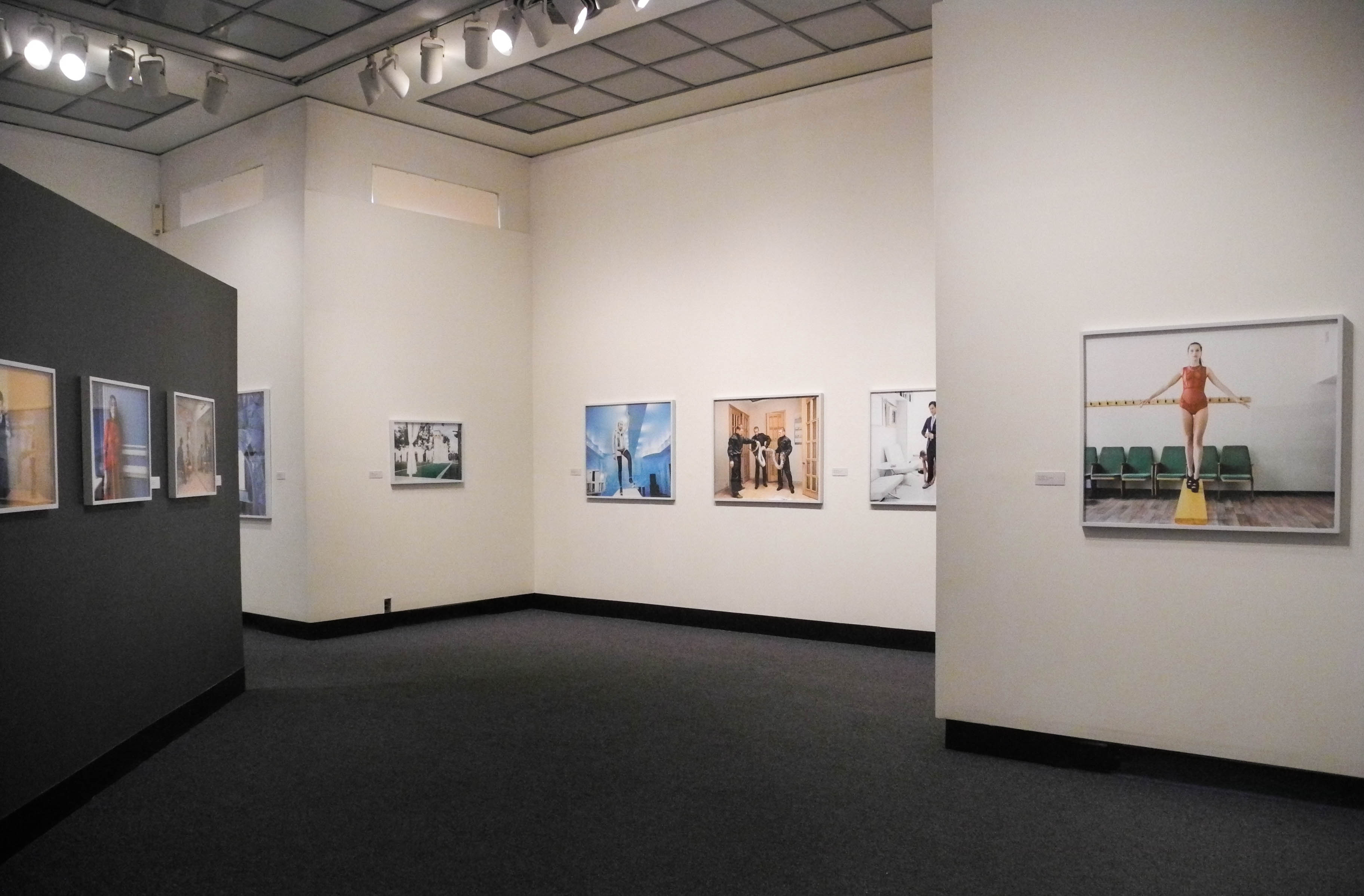
c/o Dani Smotrich-Barr, Photo Editor
Two sights immediately caught my eye when I stepped into the opening reception for “Acts and Illusions,” Davison Art Center’s current exhibit. One was “Sputnik Documentary,” a photograph directly across from the gallery entrance that features a futuristically angular, icy blue movie theater with an audience comprised of elderly viewers. They appear to be staring straight ahead into a glowing white screen that almost seems to hypnotize them. The second was the artist, Assistant Professor of Art Sasha Rudensky, who donned a black mesh shirt and silver metallic pants, which vied formidably for the room’s attention.
“Acts and Illusions,” which will be on view until December 10, spans three separate projects, 25 photos, and about 13 years of Rudensky’s work. It marks the first time that Rudensky has displayed multiple projects during a single show, but the risk pays off, as each photograph complements the others.
Rudensky’s work takes on the aesthetically pleasing color palette popularized by Wes Anderson, while also proving reminiscent of Edward Hopper’s melancholic whim. However, Rudensky’s photographs demonstrate something new and fascinating in their dynamic subject matters. Walking into the gallery is like entering some sort of post-apocalyptic sci-fi world, with ruins of a Lenin statue on one wall and lovers smoking a hookah on the other.
As Rudensky puts it herself, “Acts and Illusions” aims to capture and exemplify the “space between.” She describes this as the lonely space between a number of states: childhood and adulthood, rich and poor, safe and unsafe, knowing and not knowing, balance and falling, love and the absence of it. Most prominently, the “space between” is the one between how we present and see ourselves and how others see us. One portrait entitled “Splitting” shows a man’s strained face while he performs a split between two chairs, a literal manifestation of Rudensky’s key themes.
In 1990, at the age of 11, Rudensky moved with her family from Moscow. This is the inspiration for much of her art, which often centers on the “New East,” or life in Eastern Europe after the fall of the Soviet Union. As an Assistant Professor of Russian, East European, and Eurasian Studies as well as Art and Art History, it is easy to see how both of these disciplines figure heavily into her art.
Among the many students, faculty, and friends of Rudensky, who filled the gallery, University President Michael Roth ’78 also made an appearance.
“[Rudensky] is one of the more innovative and thoughtful photographers working in a cross-cultural medium,” said President Roth. “She has a way of going back to a familiar place like it’s another planet.”
From her cross-cultural point of view, Rudensky studies the ideological ambiguity and loss of structure left after the fall of the USSR. Many of her photographs are heavily concerned with identity, such as “Snow Queen,” which features a 17-year-old high school student who works at a strip club. The predominantly icy blue of the photograph casts an aura that aligns with Rudensky’s theme of in between-ness.
“I found her interesting because she looks both adult and childlike at the same time,” Rudensky said. “Also, she was extremely self-possessed. It was very difficult to catch her unaware. But there are cracks where she comes through. If you notice, we can see the seams of her stockings, and she doesn’t know that they are supposed to be in the back because she’s a child. I’m very interested in looking at the extent to which women in the East adopt this persona as a sexualized object.”
Rudensky’s first color photograph, and what she refers to as her “mother photograph,” is first in the order of the exhibition. It’s called “Watermelon Peels,” and shows a lonely dock leading out on to steel gray water with a watermelon peel rolled off of the dock in the dirt. Though perhaps not as shocking as “Snake Handlers,” for which Rudensky illegally rented a large snake and photographed three black-clad men handling it. The photograph brings up a central question: whether the snake is scarier, or the three men in black security uniforms carrying it. Who or what is the snake? Who or what is your snake?
“Acts and Illusions” fills the wall space in Davison to capacity, and culminates in a video installation titled “Island Complex (Fences).” The installation, which is a video shot from a car passing a gated mansion district, focuses on the fences rather than the homes themselves. There are other pieces in the collection that point to the rather odd nature of wealth in the New East, such as “Tiger Mansion,” a photographic documentation of a wealthy man’s literal fulfillment of his childhood desire to have a mansion full of tigers. In the following gallery talk, Rudensky pointed out the strange sadness of the wish to fulfill this desire, and shared that the idea for “Island Complex (Fences)” rooted from how difficult it was to access and photograph these gated communities.
Standing between “Snake Handlers” and the Byronic “Purple Suit,” Rudensky recalled standing in the same spot almost exactly 20 years ago during her own freshman year at Wesleyan, feeling like “photography was something that [she] might have an intimate relationship with for a long time.” Simultaneously, the circle is complete, drawn together by the singular idea of transformation’s awkwardness and uncertainty. It is this awkwardness and uncertainty that fuels the art to keep asking questions, seducing the viewer with the promise of being lonely and exploring that endless world together.
Stephanie Ades can be reached at sades@wesleyan.edu.
Comments are closed